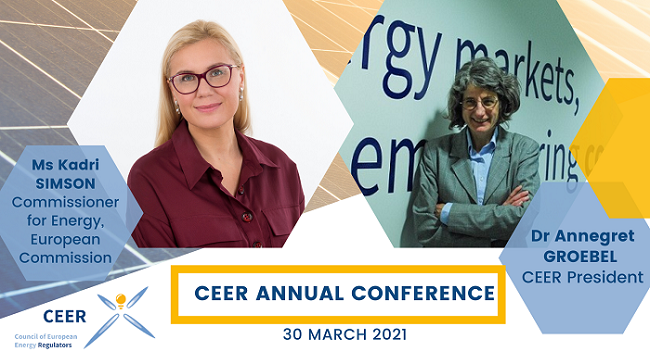| Press Release 21-01 CEER’s Annual Conference looks at the energy sector in light of both the ongoing pandemic and the Energy Transition 30 March 2021 - The energy sector’s resilience was proven, but future long-run challenges remain
- Well-regulated and deeper cross-sectoral cooperation is needed for a successful energy transition
Bringing together lessons learnt from the experience of the energy sector during the ongoing Covid-19 pandemic and the need for greater cross-sectoral integration to achieve the energy transition were themes of today’s conference “Dynamic Regulation in Practice: the energy sector during the pandemic and Energy Transition” organised by the Council of European Energy Regulators (CEER)1. This was CEER’s first-ever virtual annual conference and had some 430 attendees. The keynote address of the EU Energy Commissioner, Ms Kadri Simson, emphasised that the EU is concentrating its efforts to transform our system, and eventually reach that vision of a net zero Europe via a threefold strategy. - Making savings from the very beginning – energy efficiency;
- Electrifying where we can – boosting renewables;
- And innovating where we cannot electrify – increasing low-carbon fuels.
Commissioner Simson noted that CEER’s conclusions in its new report released yesterday “First Analysis of the COVID-19 Pandemic’s Effects on the Energy Sector” confirmed the European Commission’s initial stocktaking in June 2020 that the energy sector has proven resilient, thanks to preparedness, and quick and practical responses. Commissioner Simson expressed her thanks to the regulators that have backed restrictions on disconnections and other measures to mitigate the impact of the crisis on consumers. She noted the importance of regulators’ research and data to helping Member States to design effective policies.Commissioner Simson went on to note that she agreed with energy regulators that: Energy system integration stands out as the blueprint for planning and operating the energy system “as a whole”, across multiple energy carriers, infrastructures, and consumption sectors. It will create stronger links between them with the objective of delivering low-carbon, reliable and resource-efficient energy services, at the least possible cost for society.2  The first session on the impact of the Covid-19 Pandemic on the energy sector began with a presentation by Ms Mechthild Wörsdörfer, Director, Sustainability, Technology & Outlooks, IEA. The IEA presented a more global view, with the core message that the clean energy transition must be at the heart of the economic recovery from the pandemic. This was followed up by CEER Vice President Jean-Laurent Lastelle (who also moderated the session) presenting key findings from the aforementioned CEER first analysis of the pandemic’s effects on the energy sector via the experiences and understanding of 28 of its Member/Observer energy regulators. Some of the lessons learnt include: ensuring good and swift information flows; adapting procedures and deadlines where necessary; that a key measure was preventing disconnections of consumers; sharing the burden more widely within the sector; and that remote operations and digitalisation must be wisely utilised. A panel of short presenters and discussants followed, with virtual audience Q&A: - The Covid‐19 pandemic facilitating energy transition opportunities – Prof Jiří Jaromír Klemeš, University of Technology, Brno, Czech Republic;
- Consequences of the pandemic for energy consumers – never had so many become vulnerable so quickly – Mr Matthew Vickers, CEO, Ombudsman Services UK & Vice President National Energy Ombudsmen Network (NEON);
- Energy distribution network operator function during the pandemic crisis providing essential services – Ms Marie-Pierre Fauconnier, CEO, Sibelga.
The Second Session on sector coupling and the energy transition was moderated by CEER Vice President Wolfgang Urbantschitsch, and started with a presentation of CEER’s own work that can be seen in a series of recent White Papers (two of which done jointly with ACER), and was presented by CEER Vice President/Gas WG Chair Pedro Verdelho and CEER Electricity WG Chair Christine Materazzi-Wagner. This recent work reflects CEER’s efforts on dynamic regulation2 that follows new issues such as, in this case, proper regulation of hydrogen networks and use of power-to-gas facilities and the role of long-term storage in a decarbonising energy sector. A panel of short presenters and discussants followed, with virtual audience Q&A: - The energy sector transformation: Fit for 55 Package – Mr Miklos Gaspar, DG ENER, European Commission;
- TSO innovation for a climate-neutral European energy system – Mr Uroš Salobir, Director of the Strategic Innovation Department, ELES (Slovenian TSO);
- Hydrogen, enabling a zero-emission society – Mr Jorgo Chatzimarkakis, Secretary General, Hydrogen Europe.
The conference ended with CEER President Annegret Groebel giving a preview of CEER’s draft strategy for 2022-2025, which is now out for public consultation. She stressed the importance of well-functioning markets at national and European level, whose value was shown in the current crisis; the consumer-centric focused in the CEER-BEUC Vision 2030; and energy system integration, which was discussed today. These three regulatory dimensions create six core areas for CEER’s work. Ends - see Notes for Editors |